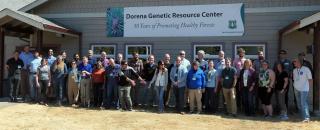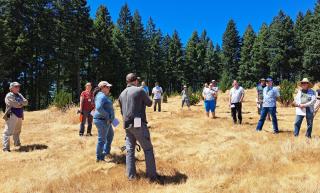Resistance breeding: Emerging tool protects future forests against pests, pathogens

MARYLAND—Scientists with the USDA Forest Service and their state counterparts in Forest Health Protection are integrating resistance breeding as a tool against pests and pathogens that threaten forest health.
The Forest Service has been leading efforts to support host resistance breeding for decades, but a recent surge of interest suggests that the approach is gaining traction.
Resistance breeding selects trees that have shown some resistance to a specific insect or pathogen as potential seed sources for reforestation. The goal is to increase resistance in tree species at greatest risk from these threats and avoid widespread loss.
This year, a session on resistance breeding was included for the first time at the annual USDA Interagency Forum on Invasive Species, held in January 2024 in Annapolis, Maryland. “This meeting truly was a watershed moment for resistance breeding efforts that have accelerated, out of necessity, to help save our trees,” said Richard Sniezko, a Forest Service geneticist who co-moderated the session.
Pest or pathogen resistance tends to increase with each generation of selection and breeding. In some systems, one to two generations of breeding may produce seed sources that can survive to reproduction age and longer. There’s been notable success in breeding species with resistance to Port-Orford-Cedar root disease, beech bark disease and fusiform rust.
Surprisingly, sometimes greater success is achieved when trees have partial, rather than complete, resistance to a pest or pathogen. With complete resistance, pests and pathogens may rapidly evolve to override resistance. Partial resistance allows the pests to coexist with the host plant, reducing pressure on the pest to evolve, while accepting that some mortality and reduction in life span may still occur.
“Trees with partial resistance may sometimes just live longer than susceptible trees,” said Forest Service research biologist Jennifer Koch, who co-moderated the resistance breeding session at January’s USDA interagency forum. “The fact that they may eventually die doesn’t negate their importance to a resistance breeding program.”
Resistance breeding has been undertaken for species with commercial value and those with high ecological importance, such as the whitebark pine, which was recently listed as threatened under the Endangered Species Act. In many cases, use of resistant seedlings for restoration and reforestation will be key to maintaining wild and urban forests in the future.
Last year, resistance breeding took center stage at a workshop at the Forest Service’s Dorena Genetic Resource Center in Oregon. Nearly all active forest tree resistance programs in the United States were represented at the three-day event. The event provided a forum to coordinate work on resistance breeding against non-native and native pests. It included a field tour of the facility at Dorena and a nearby Bureau of Land Management site that includes seed orchards and test sites for resistance breeding to white pine blister rust and Port-Orford-Cedar root disease.
Looking ahead, the Forest Service is helping to meet a growing need for workshops and training in resistance breeding. An online webinar series on tree improvement fundamentals, which will include resistance breeding, is planned for spring 2024 through a partnership with Southern Regional Extension Forestry. Planned deliverables from the Oregon workshop include a compilation of species profiles that provide overviews of the resistance programs as an aid to managers and funding agencies and to help future scientists tackle resistance breeding. Further, a national plan for resistance breeding is in the works, led by Arnaldo Ferreira, national geneticist and director of the National Forest Genetics Laboratory, to help coordinate and support new and existing programs.


